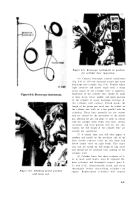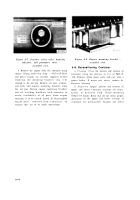TM-9-2815-200-35
ENGINE, WITH CONTAINER:TURBOSUPERCHARGED, DIESEL ,FUEL INJECTION ,90-DEGREE “V” TYPE, AIR - COOLED ,12 - CYLINDER , ASSEMBLY ;MODELS AVDS-1790-2M (2815-856-4996), AVDS-1790-2A AND AVDS-1790-2AM (2815-856-9005)
TECHNICAL MANUAL; DIRECT SUPPORT, GENERAL SUPPORT AND DEPOT MAINTENANCE MANUAL INCLUDING REPAIR PARTS AND SPECIAL TOOLS LISTS
TM-9-2815-200-35 - Page 558 of 779
tative sample indicates that such mounts will
perform in accordance with test requirements of
Specification MIL-M-45907.
(5) Replace unserviceable skids. Fabricate
skids from wood conforming to Class A of MIL-
W-3912. Wood shall be pressure creosoted in
accordance with requirements of TT-W-57.
(6) If interior or exterior of containe r
required removal of paint or rust by power
buffing, apply spot prime and paint, as required.
If container required abrasive blasting, remove
grit and coat with one coat of primer 8010-161-
5718 (TT-P-636) or 8010-298-3867 (TT-E -
529) or 8010-292-3741 (TT-E-485) Type IV )
as prescribed by TM 9-213.
e. Assembly and Pressure Check.
(1)
Assembly.
Coat a new or serviceable
sealing gasket or “O” ring with a thin, uniform
film of sealing compound conforming to MIL-1-
8660 and install on lower section mounting
flange. Install air pressure gage in place of relief
valve (fig. 8-7). Assemble upper and lower
sections of container and torque tighten bolts to
90-105 lbs. ft.
(2)
Pressure
test. Pressurize the container to
10 psi using air that has passed through water
separator - 4920-242-400 or equivalent. Im-
merse container in water. Evidence of ai r
bubbles due to air leaks will be cause fo r
rejection and rework. The alternate method of
checking
is to pressuriz e
container to th e
specified 10 psi and allow container to stand for
a-minimum of 12 hours. Any appreciable drop in
pressure will be sufficient cause for rejection. If
the containe r
air pressure is maintaine d
satisfactorily, release
pressure, remove ai r
pressure gage and install relief valve.
f. Container Markings. The
container shall be
marked in accordance with MIL-STD-129 and
as follows:
(1) Adjacent to lifting rings, eyes, or lugs,
(with arrows 5 inches long pointing thereto),
mark in 10 inch letters, LIFT HERE.
(2) Adjacent to and above air-filling valve,
mark in 1-inch letters, AIR VALVE, and below,
FILL TO 5 POUNDS PRESSURE .
(3) Adjacent to and below air-filling valve,
mark in 1-inch letters, USE DRY AIR ONLY.
(4) Adjacent to and above the item-record
receptacle, mark in ½-inch letters, RECORDS.
(5) Adjacent to and above the humidity
indicator, mark in ½-inch letters, HUMIDITY
INDICATOR .
(6) Adjacent to and, above the relief valve,
mark in ½-inch letters, RELIEF VALVE, and
below, DO NOT DISTURB .
(7) Along warning closure flange on both
sides of the container, mark in 1-inch letters,
WARNING :
RELEAS E
PRESSUR E
BEFORE OPENING CONTAINER .
(8) At loaded center of balance (43-inches
from relief valve end) on both sides of the lower
section of the container, mark a vertical line 6-
inches high and 1-inch wide with adjacent 1-inch
letters, CENTER OF BALANCE .
(9) Each container shall be provided with a
name plate conforming to Specification MIL-P-
13525 and shall be secured to the recor d
receptacle end of container.
(10) Each container shall contain a decal
(10912360)
with
instruction
for
assembling
container. Decal will be secured to the inner wall
(fig. 8-9) of the lower section at the name plate
end of the container.
g. Preparation of empty container for Ship-
ment or Storage.
After the container has been
reconditioned, pressure checked, and has had the
proper markings added, remove the uppe r
section of the container. Install and secure the
mounting brackets and hardware used to secure
the engine in the container. Apply a film of
sealing compound conforming to MIL-I-8660 on
the container gasket and assemble container.
Torque tighten the bolts to 90-105 lbs ft. Add 5
to 7 psi of dry air and allow sufficient time to
insure that the air pressure is retained.
8-11. Engine Preservation
a. Preservation Through the Fuel System.
Equip an auxiliary fuel container, with a fuel
line, an d
-
fill with a sufficient amount o f
preservative oil, conforming to Specification VV-
L-800, to operate the engine as prescribed below.
Arrange the container to provide adequat e
pressure t o
assure prope r
supply
of
th e
preservative oil to the fuel system. Disconnect
the fuel line at the most convenient point nearest
to the engine fuel pump and connect the line
from the auxiliary fuel container to the fuel-to-
engine line at the point of disconnect. Disconnect
the engin e
fuel
return
line
at
the
quick
disconnect coupling and connect a transparent
plastic line to the disconnected engine fuel return
line with the other end inserted into a recovery
container to collect the returned diesel fuel. The
fuel valve on the auxiliary fuel container shall be
8-16
Back to Top




















